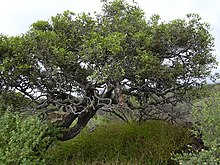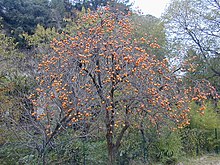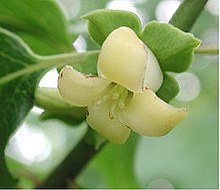Ebenaceae
| Ebenaceae | |
|---|---|

| |
| Diospyros sandwicensis | |
| Scientific classification | |
| Kingdom: | |
| (unranked): | |
| (unranked): | |
| (unranked): | |
| Order: | |
| Family: | Ebenaceae |
| Genera | |
|
See text | |
The Ebenaceae are a family of flowering plants belonging to order Ericales. It includes ebony and persimmon among about 768[2] species of trees and shrubs. The family is distributed across the tropical and warmer temperate regions of the world.[3] The family is most diverse in the rainforests of Malesia, India, tropical Africa and tropical America.[4]




Many species are valued for their wood, particularly ebony, for fruit, and as ornamental plants.
Biology
The fruits contain tannins, a plant defense against herbivory, so they are often avoided by animals when unripe. The ripe fruits of many species are a food source for diverse animal taxa. The foliage is consumed by insects.
The plants may have a strong scent. Some species have aromatic wood. They are important and conspicuous trees in many of their native ecosystems, such as lowland dry forests of the former Maui Nui in Hawaii,[5] Caspian Hyrcanian mixed forests, Kathiarbar-Gir dry deciduous forests, Louisiade Archipelago rain forests, Madagascar lowland forests, Narmada Valley dry deciduous forests, New Guinea mangroves, and South Western Ghats montane rain forests.
Ebony is a dense black wood taken from several species in the genus Diospyros, including Diospyros ebenum (Ceylon ebony, Indian ebony), Diospyros crassiflora (West African ebony, Benin ebony), and Diospyros celebica (Makassar ebony). Diospyros tesselaria (Mauritius ebony) was heavily exploited by the Dutch in the 17th century.
Description
The family includes trees and shrubs. The leaves are usually alternately arranged, but some species have opposite or whorled leaves. The inflorescence is usually a cyme of flowers, sometimes a raceme or a panicle, and some plants produce solitary flowers. Most species are dioecious. The flower has 3 to 8 petals, which are joined at the bases. There are usually several single or paired stamens, which are often attached to the inner wall of the corolla. Female flowers have up to 8 stigmas.[3] The calyx is persistent.[6] The fruits are berry-like or capsular.[3] Like the wood of some species, the roots and bark may be black in color.[6]
Etymology
The family name Ebenaceae is based on the genus name Ebenus, published by Otto Kuntze in 1891.[7] It is a later homonym of Ebenus L., a genus already named in the family Fabaceae, and is thus nomen illegitimum. The plant that Kuntze had named Ebenus was accordingly reassigned to the genus Maba, which in turn has since been included in the genus Diospyros.
Because the name Ebenaceae had become well known, having been used in major botanical references such as Bentham and Hooker's Genera Plantarum, Engler and Prantl's Natürlichen Pflanzenfamilien, and Hutchinson's Families of Flowering Plants, it was conserved[8] and is therefore legitimate.[9]
Genera
During the last century, seven genera have been included in the family at one time or another.[3] One phylogenetic analysis reduced the family to four genera:[6]
| Genus | Authority | Citation | Date |
|---|---|---|---|
| Diospyros | L. | Sp. Pl. 2: 1057–1058 | 1753 |
| Euclea | L. | Syst. Veg. (ed. 13) 747 | 1774 |
| Lissocarpa[10] | Benth. | Gen. Pl. 2(2): 667, 671 | 1876 |
| Royena | L. | Sp. Pl. 1: 397 | 1753 |
References
- ^ Angiosperm Phylogeny Group (2009). "An update of the Angiosperm Phylogeny Group classification for the orders and families of flowering plants: APG III" (PDF). Botanical Journal of the Linnean Society. 161 (2): 105–121. doi:10.1111/j.1095-8339.2009.00996.x. Retrieved 2013-06-26.
- ^ "Ebenaceae — The Plant List". Theplantlist.org. Retrieved 2012-08-13.
- ^ a b c d James E. Eckenwalder. "Ebenaceae". Flora of North America. Vol. 8.
- ^ José Manuel Sánchez de Lorenzo-Cáceres. "Arboles Ornamentales".
- ^ The Nature Conservancy – Hawaiʻi Operating Unit (March 2004). "Kānepuʻu Preserve Lānaʻi, Hawaiʻi Long-Range Management Plan Fiscal Years 2005–2010" (PDF). Hawaii Department of Land & Natural Resources Natural Area Partnership Program: 3. Retrieved 2009-04-09.
{{cite journal}}: Cite journal requires|journal=(help) - ^ a b c Duangjai, S., et al. (2006). Generic delimitation and relationships in Ebenaceae sensu lato: evidence from six plastid DNA regions. American Journal of Botany 93(12), 1808-27.
- ^ "Index Nominum Genericorum (ING)".
- ^ Bullock, A. A. (1959). "Nomina Familiarum Conservanda Proposita (Continued)". Taxon. 8 (5): 154–181. doi:10.2307/1216755. JSTOR 1216755.
- ^ "International Code of Botanical Nomenclature (Vienna Code)".
{{cite web}}:|chapter=ignored (help) - ^ Lissocarpa. The Plant List. Accessed 13 August 2012.
